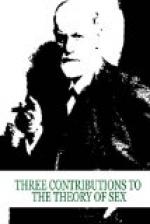(b) They are amphigenously inverted (psychosexually hermaphroditic); i.e., their sexual object may belong indifferently to either the same or to the other sex. The inversion lacks the character of exclusiveness.
(c) They are occasionally inverted; i.e., under certain external conditions, chief among which are the inaccessibility of the normal sexual object and initiation, they are able to take as the sexual object a person of the same sex and thus find sexual gratification.
The inverted also manifest a manifold behavior in their judgment about the peculiarities of their sexual impulse. Some take the inversion as a matter of course, just as the normal person does regarding his libido, firmly demanding the same rights as the normal. Others, however, strive against the fact of their inversion and perceive in it a morbid compulsion.[4]
Other variations concern the relations of time. The characteristics of the inversion in any individual may date back as far as his memory goes, or they may become manifest to him at a definite period before or after puberty.[5] The character is either retained throughout life, or it occasionally recedes or represents an episode on the road to normal development. A periodical fluctuation between the normal and the inverted sexual object has also been observed. Of special interest are those cases in which the libido changes, taking on the character of inversion after a painful experience with the normal sexual object.
These different categories of variation generally exist independently of one another. In the most extreme cases it can regularly be assumed that the inversion has existed at all times and that the person feels contented with his peculiar state.
Many authors will hesitate to gather into a unit all the cases enumerated here and will prefer to emphasize the differences rather than the common characters of these groups, a view which corresponds with their preferred judgment of inversions. But no matter what divisions may be set up, it cannot be overlooked that all transitions are abundantly met with, so that the formation of a series would seem to impose itself.
Conception of Inversion.—The first attention bestowed upon inversion gave rise to the conception that it was a congenital sign of nervous degeneration. This harmonized with the fact that doctors first met it among the nervous, or among persons giving such an impression. There are two elements which should be considered independently in this conception: the congenitality, and the degeneration.




